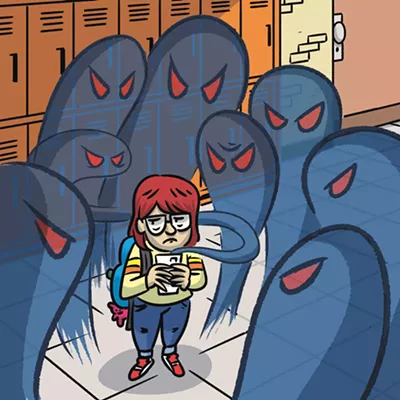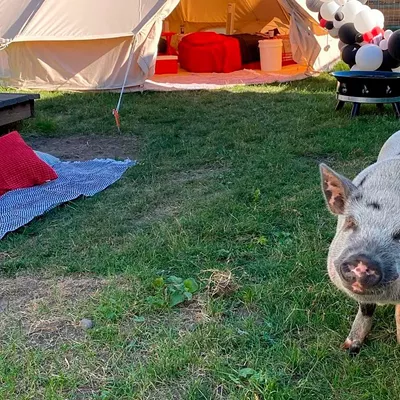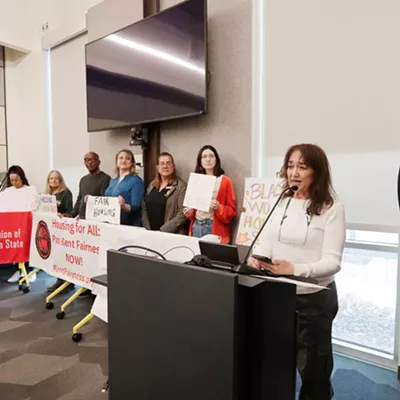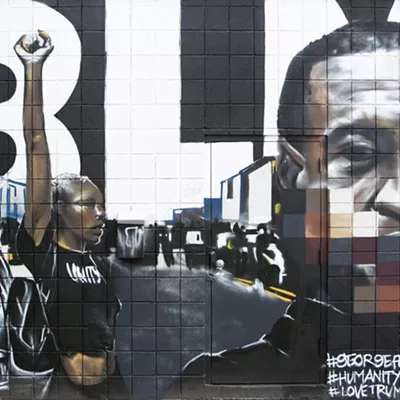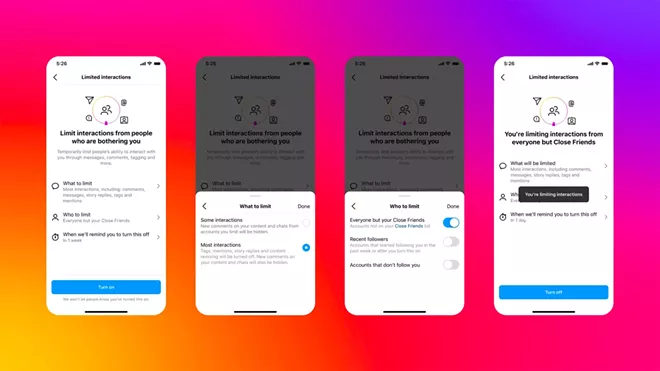
These days, up to 95% of teens use social media, and a third of them say they use it almost constantly, the U.S. Surgeon General reported in 2023. With this near universal usage, social media apps like Instagram have become a hotbed for harassment and cyberbullying, leaving Meta, the company behind Instagram and Facebook, in search of ways to make their platforms safer for youth.
While Instagram has strict anti-bullying policies in place, Meta spokesperson Dayna Geldwert says that some of today's bullying can skirt the platform's established rules.
"We know that parents and teens think a lot about how to prevent bullying online, but not everything goes against our rules," she says. "Something that may be innocuously phrased, which may be seemingly fine to other people, wouldn't be flagged as bullying."
To address this, Meta is utilizing some of Instagram's current features in new ways to prevent instances of bullying from continuing to slip through the cracks, Geldwert says.
The first tool that's been adapted is Limits, which was introduced a few years back to hide direct messages (DMs) and comments from people who don't follow your account. This has been expanded so users can restrict their comment sections and DMs to a list of their closest friends — rather than all of their followers.
Geldwert says this is meant to be utilized in "high sensitivity, high severity moments," which are usually characterized by Instagram as a "bullying campaign" where there is an influx of comments or followers on one person's account. In these instances, Instagram will reach out to the user and ask if they'd like to turn on Limits for their account.
The other tool that has been updated is called Restrict, which gives users the ability to restrict how people interact with their account. Geldwert says she's heard that this is one of the features that teens appreciate the most.
Now, she says, it gives these users the power to preview comments on their posts and then choose to either delete them, post them or ignore them.
"We've seen that teens want to keep tabs when people are saying things about them, but they just don't want other people to see them," Geldwert explains. "Restrict gives [teens] more control and ownership of their account."
Additionally, these changes make it so teens don't have to utilize the app's blocking feature.
"These new updates alleviate the burden on teens to confront bullies by blocking or reporting them," Meta states. "Now, teens can easily protect themselves without provoking further harassment and future retaliation."
"Blocking someone seems extra, especially when it's the person you sit next to in math class," Geldwert adds.
The updates are currently live on Instagram, so teen users can begin to access them as soon as they want, but that doesn't mean that cyberbullying has been "fixed." Teens in Spokane County are reporting higher levels of bullying than their state and national counterparts, but organizations like NAMI (National Alliance on Mental Illness) Spokane and Spokane Public Schools are working to reduce online harassment and improve students' well-being.
'KEYBOARD COURAGE'
Bullying has existed for far longer than any social media platform. However, the rise in popularity of social media sites among teens has created an environment where cyberbullying thrives.
Chauntelle Lieske, the NAMI Spokane executive director, says this has only gotten worse since the pandemic's onset in 2020 pushed more teens online.
In 2019, teens spent more than seven hours per day on their phones, which grew to nearly nine hours per day in 2021, not including screen time spent on academics, according to data compiled by the nonprofit Common Sense, which advocates for online safety.
Lieske says the increased social media use and an uptick in reported cyberbullying incidents has led to more teens experiencing mental health issues like depression or even eating disorders.
But where is all this bullying on social media coming from?
Lieske thinks it's likely tied to something she calls "keyboard courage." As she describes it, the ability to hide behind a keyboard and screen makes it easier to say things that normally wouldn't be said in person.
"People aren't people anymore when you're behind a screen," Lieske says.
While she says it's impossible to pinpoint why people choose to bully others online, statistics seem to point toward this "keyboard courage" as a strong conduit for that type of behavior.
Nearly half (46%) of U.S. teens have reported experiencing some form of cyberbullying, according to a 2022 study from the Pew Research Center. These include instances of offensive name-calling, spreading false rumors, receiving explicit images without their consent, and even threats of physical violence.
Meanwhile, less than 20% of teens reported in-person bullying during the 2021-22 school year, according to the National Center for Education Statistics. That percentage gets higher as the data is localized to Washington state (about 23%) and Spokane County (about 25%), according to the Washington Office of Superintendent of Public Instruction's Healthy Youth Survey.
But despite the widespread social media usage among kids and teens, researchers haven't conducted "robust independent safety analyses on the impact of social media on youth," the Surgeon General's 2023 report states. "There are increasing concerns among researchers, parents and caregivers, young people, health care experts, and others about the impact of social media on youth mental health."
NO PHONES IN CLASS?
For the last decade, Ryan Lancaster has overseen the Spokane Public Schools' social media accounts. In that time he's seen social media platforms grow into an unsafe place for the district's students.
"When I first started it was a platform for information and keeping in touch," he says. "Now I'm seeing it morph into this place that is filled with lots of misinformation and stuff that doesn't serve anyone. Every principal I've engaged with on this topic has told me the same thing — social media is harming our kids."
That harm can come in many forms, Lancaster says. Often it's just a classroom distraction that prevents students from learning and requires school staff to step in. But sometimes online confrontations manifest into real world confrontations, creating a larger risk of student violence.
Additionally, he says that the near universal usage of social media among youth is making it impossible to separate what's happening online from day-to-day life.
To address some of these issues, Lancaster says the SPS Board of Directors is considering changing its policies to prevent cellphone usage in its schools. They've already completed a yearlong pilot program by implementing a no cellphone policy at Salk Middle School.
In that time, Salk staff members have seen a blossoming of peer-to-peer connections that they may not have seen if the policy had not been implemented, Lancaster explains.
"The school board is now weighing how to develop a districtwide policy that would still allow students to have phones on their person, but also not letting cellphones drive students' every day," he says.
It's unclear when a decision on the phone policy might be made.
As for the changes Meta is making to Instagram, Lancaster isn't so sure they'll be effective.
"I love the idea of what Meta is doing, and I hope that Meta steps up, but I'm skeptical," he says.
School principals often approach Lancaster regarding inflammatory posts that one student made toward another, he says. But there's really nothing that he can do to stop that, besides filing a report to Instagram like anyone else would.
"It'd be nice to get some more help from [Meta]. I think they should work on giving more resources to actually address problems, like cyberbullying," he says.

OPEN PARTICIPATION
Restricting phones in class isn't the only thing SPS is considering. The district's main initiative to decrease phone usage is to get students involved in some type of extracurricular activity.
"There's a proven correlation that participating in extracurriculars can get a kid off the screen, reducing the risk of mental health problems," Lancaster says. "It's almost the antithesis of social media."
Stephanie Splater, SPS director of athletics and after-school programs, has been tasked with leading this charge, with the goal of 80% student participation by 2028. While she doesn't have an exact count, Splater can confirm that the district is currently sitting just above 50% student participation in extracurricular activities.
While the 80% goal may seem ambitious in a district of about 30,000 students, Splater says SPS has a few policies in place that can increase participation.
First, she says none of the district's sports teams are allowed to cut those who try out, meaning someone's skill level won't prevent them from participating in a sport of their choosing. For example, two of the district's schools have four softball teams and three other schools have three teams each. Other activities like volleyball and tennis have close to 100 participants at those same schools.
In addition to the more accessible sports teams, Splater says she's made it her goal to initiate as many after school clubs and activities as possible — as long as some students are showing an interest.
"I think our thought process is about balance," she says. "It's about enjoying being at cross country practice at Manito Park on a fall afternoon, and not having your phone with you because it's such a great experience. Or it's about having it nearby because you might be looking something up, but you're engaged in the activity interacting with other people."
She says that interaction was lost during the pandemic, so it's more important now than ever before to have students interacting with each other, instead of their phones.
"We're not anti-technology, because so many opportunities for students do incorporate technology," she says. "I just think that interacting with others and feeling connected to a community is super important for these kids and their mental well-being." ♦



